Sean Connery
Sir Thomas Sean Connery (born 25 August 1930) is a Scottish actor and producer who has won an Academy Award, two BAFTA Awards (one being a BAFTA Academy Fellowship Award), and three Golden Globes, including the Cecil B. DeMille Award and a Henrietta Award.
Sean Connery | |
|---|---|
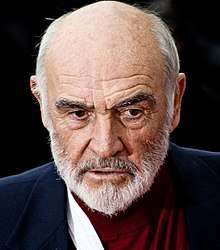 Connery attending the 2008 Edinburgh International Film Festival | |
| Born | Thomas Sean Connery 25 August 1930 Fountainbridge, Edinburgh, Scotland |
| Occupation | Actor |
| Years active | 1954–2006, 2012 |
| Spouse(s) |
|
| Children | Jason Connery |
| Family | Neil Connery (brother) |
| Military career | |
| Allegiance | |
| Service/ | |
| Years of service | 1946–1949 |
| Rank | Able Seaman |
| Unit | HMS Formidable |
| Website | seanconnery |
| Signature | |
 | |
Connery was the first actor to portray the character James Bond in film, starring in seven Bond films (every film from Dr. No to You Only Live Twice, plus Diamonds Are Forever and Never Say Never Again), between 1962 and 1983.[1] In 1988, Connery won the Academy Award for Best Supporting Actor for his role in The Untouchables. His films also include Marnie (1964), Murder on the Orient Express (1974), The Man Who Would Be King (1975), The Name of the Rose (1986), Highlander (1986), Indiana Jones and the Last Crusade (1989), The Hunt for Red October (1990), Dragonheart (1996), The Rock (1996), and Finding Forrester (2000).
Connery has been polled in The Sunday Herald as "The Greatest Living Scot"[2] and in a EuroMillions survey as "Scotland's Greatest Living National Treasure".[3] He was voted by People magazine as both the “Sexiest Man Alive" in 1989 and the "Sexiest Man of the Century” in 1999.[4] He received a lifetime achievement award in the US with a Kennedy Center Honor in 1999. Connery was knighted in the 2000 New Year Honours for services to film drama.[5]
Early life
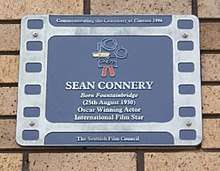
Thomas Sean Connery, named Thomas after his grandfather, was born in Fountainbridge, Edinburgh, Scotland on 25 August 1930.[6] His mother, Euphemia "Effie" McBain McLean, was a cleaning woman. She was born the daughter of Neil McLean and Helen Forbes Ross, and named after her father's mother Euphemia McBain, wife of John McLean and daughter of William McBain from Ceres in Fife.[7][8][9] Connery's father, Joseph Connery, was a factory worker and lorry driver.[10][11] His paternal grandfather's parents emigrated to Scotland from Ireland in the mid-19th century.[12] The remainder of his family was of Scottish descent, and his maternal great-grandparents were native Scottish Gaelic speakers from Fife (unusually, for a speaker of the language), and Uig on Skye.[13][14] His father was a Roman Catholic, and his mother was a Protestant. He has a younger brother, Neil. Connery has said that he was called Sean, his middle name, long before becoming an actor, explaining that when he was young he had an Irish friend named Séamus and that those who knew them both had decided to call Connery by his middle name whenever both were present. He was generally referred to in his youth as "Tommy".[15] Although he was small in primary school, he grew rapidly around the age of 12, reaching his full adult height of 6 ft 2 in (188 cm) at 18. He was known during his teen years as "Big Tam", and has stated that he lost his virginity to an adult woman in an ATS uniform at the age of 14.[16][17]
Connery's first job was as a milkman in Edinburgh with St. Cuthbert's Co-operative Society.[18] In 2009, Connery recalled a conversation in a taxi:
When I took a taxi during a recent Edinburgh Film Festival, the driver was amazed that I could put a name to every street we passed. "How come?" he asked. "As a boy I used to deliver milk round here," I said. "So what do you do now?" That was rather harder to answer.[13]
In 1946, at the age of 16, Connery joined the Royal Navy, during which time he acquired two tattoos, of which his official website says "unlike many tattoos, his were not frivolous—his tattoos reflect two of his lifelong commitments: his family and Scotland. ... One tattoo is a tribute to his parents and reads 'Mum and Dad,' and the other is self-explanatory, 'Scotland Forever.'"[19] He trained in Portsmouth at the naval gunnery school and in an anti-aircraft crew. He was later assigned as an Able Seaman on HMS Formidable.[20] Connery was later discharged from the navy age 19 on medical grounds because of a duodenal ulcer, a condition that affected most of the males in previous generations of his family.[21]
Afterwards, he returned to the co-op, then worked as, among other things, a lorry driver, a lifeguard at Portobello swimming baths, a labourer, an artist's model for the Edinburgh College of Art, and after a suggestion by former Mr. Scotland, Archie Brennan,[22][23] a coffin polisher. The modelling earned him 15 shillings an hour.[23] Artist Richard Demarco, at the time a student who painted several early pictures of Connery, described him as "very straight, slightly shy, too, too beautiful for words, a virtual Adonis".[24]
Connery began bodybuilding at the age of 18, and from 1951 trained heavily with Ellington, a former gym instructor in the British Army.[25] While his official website claims he was third in the 1950 Mr. Universe contest, most sources place him in the 1953 competition, either third in the Junior class[26] or failing to place in the Tall Man classification.[27] Connery stated that he was soon deterred from bodybuilding when he found that the Americans frequently beat him in competitions because of sheer muscle size and, unlike Connery, refused to participate in athletic activity which could make them lose muscle mass.[28]
Connery was a keen footballer, having played for Bonnyrigg Rose in his younger days.[29] He was offered a trial with East Fife. While on tour with South Pacific, Connery played in a football match against a local team that Matt Busby, manager of Manchester United, happened to be scouting.[30] According to reports, Busby was impressed with his physical prowess and offered Connery a contract worth £25 a week (equivalent to £703 in 2019) immediately after the game. Connery admits that he was tempted to accept, but he recalls, "I realised that a top-class footballer could be over the hill by the age of 30, and I was already 23. I decided to become an actor and it turned out to be one of my more intelligent moves."[31]
Career
1950s
Seeking to supplement his income, Connery helped out backstage at the King's Theatre in late 1951.[26] He became interested in the proceedings, and a career was launched. During a bodybuilding competition held in London in 1953, one of the competitors mentioned that auditions were being held for a production of South Pacific,[26] and Connery landed a small part as one of the Seabees chorus boys. By the time the production reached Edinburgh, he had been given the part of Marine Cpl Hamilton Steeves and was understudying two of the juvenile leads, and his salary was raised from £12 to £14–10s a week.[32] The production returned the following year out of popular demand, and Connery was promoted to the featured role of Lieutenant Buzz Adams, which Larry Hagman had portrayed in the West End.[32]
While in Edinburgh, Connery was targeted by the Valdor gang, one of the most violent in the city. He was first approached by them in a billiard hall where he prevented them from stealing his jacket and was later followed by six gang members to a 15-foot-high balcony at the Palais.[33] There Connery launched an attack singlehandedly against the gang members, grabbing one by the throat and another by a biceps and cracked their heads together. From then on he was treated with great respect by the gang and gained a reputation as a "hard man".[34]
Connery first met Michael Caine at a party during the production of South Pacific in 1954, and the two later became close friends.[32] During the production of South Pacific at the Opera House, Manchester over the Christmas period of 1954, Connery developed a serious interest in the theatre through American actor Robert Henderson who lent him copies of the Henrik Ibsen works Hedda Gabler, The Wild Duck, and When We Dead Awaken, and later listed works by the likes of Marcel Proust, Leo Tolstoy, Ivan Turgenev, George Bernard Shaw, James Joyce and William Shakespeare for him to digest.[35] Henderson urged him to take elocution lessons and got him parts at the Maida Vale Theatre in London. He had already begun a film career, having been an extra in Herbert Wilcox's 1954 musical Lilacs in the Spring alongside Anna Neagle.[36]
Although Connery had secured several roles as extras, he was struggling to make ends meet, and was forced to accept a part-time job as a babysitter for journalist Peter Noble and his actress wife Marianne, which earned him 10 shillings a night.[36] He met Hollywood actress Shelley Winters one night at Noble's house, who described Connery as "one of the tallest and most charming and masculine Scotsmen" she'd ever seen, and later spent many evenings with the Connery brothers drinking beer.[36] Around this time Connery was residing at TV presenter Llew Gardner's house. Henderson landed Connery a role in a £6 a week Q Theatre production of Agatha Christie's Witness for the Prosecution, during which he met and became friends with fellow-Scot Ian Bannen.[37] This role was followed by Point of Departure and A Witch in Time at Kew, a role as Pentheus opposite Yvonne Mitchell in The Bacchae at the Oxford Playhouse, and a role opposite Jill Bennett in Eugene O'Neill's production of Anna Christie.[37]
During his time at the Oxford Theatre, Connery won a brief part as a boxer in the TV series The Square Ring, before being spotted by Canadian director Alvin Rakoff, who gave him multiple roles in The Condemned, shot on location in Dover in Kent. In 1956, Connery appeared in the theatrical production of Epitaph, and played a minor role as a hoodlum in the "Ladies of the Manor" episode of the BBC Television police series Dixon of Dock Green.[37] This was followed by small television parts in Sailor of Fortune and The Jack Benny Program.[37]
In early 1957, Connery hired agent Richard Hatton who got him his first film role, as Spike, a minor gangster with a speech impediment in Montgomery Tully's No Road Back alongside Skip Homeier, Paul Carpenter, Patricia Dainton and Norman Wooland.[38] In April 1957, Rakoff—after being disappointed by Jack Palance—decided to give the young actor his first chance in a leading role, and cast Connery as Mountain McLintock in BBC Television's production of Requiem For a Heavyweight, which also starred Warren Mitchell and Jacqueline Hill. He then played a rogue lorry driver, Johnny Yates, in Cy Endfield's Hell Drivers (1957) alongside Stanley Baker, Herbert Lom, Peggy Cummins and Patrick McGoohan.[39] Later in 1957, Connery appeared in Terence Young's poorly received MGM action picture Action of the Tiger opposite Van Johnson, Martine Carol, Herbert Lom and Gustavo Rojo; the film was shot on location in southern Spain.[40][41] He also had a minor role in Gerald Thomas's thriller Time Lock (1957) as a welder, appearing alongside Robert Beatty, Lee Patterson, Betty McDowall and Vincent Winter; this commenced filming on 1 December 1956 at Beaconsfield Studios.[42]
Connery had a major role in the melodrama Another Time, Another Place (1958) as a British reporter named Mark Trevor, caught in a love affair opposite Lana Turner and Barry Sullivan. During filming, star Turner's possessive gangster boyfriend, Johnny Stompanato, who was visiting from Los Angeles, believed she was having an affair with Connery.[43] Connery and Turner had attended West End shows and London restaurants together.[44] Stompanato stormed onto the film set and pointed a gun at Connery, only to have Connery disarm him and knock him flat on his back. Stompanato was banned from the set.[45] Two Scotland Yard detectives advised Stompanato to leave and escorted him to the airport, where he boarded a plane back to the US.[46] Connery later recounted that he had to lie low for a while after receiving threats from men linked to Stompanato's boss, Mickey Cohen.[44]
In 1959 Connery landed a leading role in Robert Stevenson's Walt Disney Productions film Darby O'Gill and the Little People (1959) alongside Albert Sharpe, Janet Munro, and Jimmy O'Dea. The film is a tale about a wily Irishman and his battle of wits with leprechauns. Upon the film's initial release, A. H. Weiler of The New York Times praised the cast (save Connery whom he described as "merely tall, dark, and handsome") and thought the film an "overpoweringly charming concoction of standard Gaelic tall stories, fantasy and romance."[47] He also had prominent television roles in Rudolph Cartier's 1961 productions of Adventure Story and Anna Karenina for BBC Television, in the latter of which he co-starred with Claire Bloom.[48]
James Bond: 1962–1971, 1983
.jpg)
Connery's breakthrough came in the role of British secret agent James Bond. He was reluctant to commit to a film series, but understood that if the films succeeded, his career would greatly benefit.[49] He played 007 in the first five Bond films: Dr. No (1962), From Russia with Love (1963), Goldfinger (1964), Thunderball (1965), and You Only Live Twice (1967) – then appeared again as Bond in Diamonds Are Forever (1971) and Never Say Never Again (1983). All seven films were commercially successful. James Bond, as portrayed by Connery, was selected as the third-greatest hero in cinema history by the American Film Institute.[50]
Connery's selection for the role of James Bond owed a lot to Dana Broccoli, wife of producer Albert "Cubby" Broccoli, who is reputed to have been instrumental in persuading her husband that Connery was the right man.[51] James Bond's creator, Ian Fleming, originally doubted Connery's casting, saying, "He's not what I envisioned of James Bond looks", and "I'm looking for Commander Bond and not an overgrown stunt-man", adding that Connery (muscular, 6' 2", and a Scot) was unrefined.[52] Fleming's girlfriend Blanche Blackwell told him that Connery had the requisite sexual charisma, and Fleming changed his mind after the successful Dr. No première. He was so impressed, he wrote Connery's heritage into the character. In his 1964 novel You Only Live Twice, Fleming wrote that Bond's father was Scottish and from Glencoe.[52]
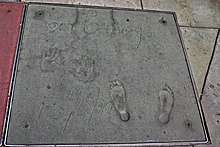
Connery's portrayal of Bond owes much to stylistic tutelage from director Terence Young, which helped polish the actor while using his physical grace and presence for the action. Lois Maxwell, who played Miss Moneypenny, related that "Terence took Sean under his wing. He took him to dinner, showed him how to walk, how to talk, even how to eat."[53] The tutoring was successful; Connery received thousands of fan letters a week after Dr. No’s opening, and the actor became a major male sex symbol in film.[54]
During the filming of Thunderball in 1965, Connery's life was in danger in the sequence with the sharks in Emilio Largo's pool. He had been concerned about this threat when he read the script. Connery insisted that Ken Adam build a special Plexiglas partition inside the pool, but this was not a fixed structure, and one of the sharks managed to pass through it. He had to abandon the pool immediately.[55] In 2005, From Russia with Love was adapted by Electronic Arts into a video game, titled James Bond 007: From Russia with Love, which featured all-new voice work by Connery, recorded by Terry Manning in the Bahamas, as well as his likeness, and those of several of the film's supporting cast.[56]
Beyond Bond
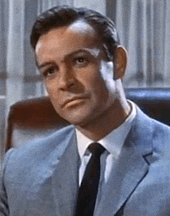
Although Bond had made him a star, Connery grew tired of the role and the pressure the franchise put on him, saying "[I am] fed up to here with the whole Bond bit"[57] and "I have always hated that damned James Bond. I'd like to kill him".[58] Michael Caine said of the situation, "If you were his friend in these early days you didn't raise the subject of Bond. He was, and is, a much better actor than just playing James Bond, but he became synonymous with Bond. He'd be walking down the street and people would say, "Look, there's James Bond." That was particularly upsetting to him."[59]
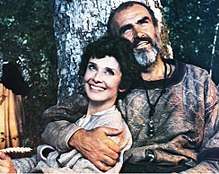
While making the Bond films, Connery also starred in other films such as Alfred Hitchcock's Marnie (1964) and The Hill (1965). Connery was offered the lead role in Michaelangelo Antonioni's film about "swinging London", Blowup (1966), but turned it down because Antonioni would not show him the complete script: only a summary that was stored in a cigarette packet.[60]
Having played Bond six times, Connery's global popularity was such that he shared a Golden Globe Henrietta Award with Charles Bronson for "World Film Favorite – Male" in 1972.[61] He appeared in John Huston’s The Man Who Would Be King (1975), starring opposite Michael Caine, with both actors regarding it as their favourite film.[62][63] The same year, he appeared in The Wind and the Lion, and in 1976 played Robin Hood in Robin and Marian where he starred opposite Audrey Hepburn who played Maid Marian. Film critic Roger Ebert – who had praised the double act of Connery and Caine in The Man Who Would Be King – praised Connery’s chemistry with Hepburn, writing, "Connery and Hepburn seem to have arrived at a tacit understanding between themselves about their characters. They glow. They really do seem in love."[64] In the 1970s Connery was part of ensemble casts in films such as Murder on the Orient Express (1974) with Vanessa Redgrave and John Gielgud, and A Bridge Too Far (1977) co-starring Dirk Bogarde and Laurence Olivier.[65]
In 1981 Connery appeared in the film Time Bandits as Agamemnon. The casting choice derives from a joke Michael Palin included in the script, in which he describes the character removing his mask as being "Sean Connery — or someone of equal but cheaper stature".[66] When shown the script, Connery was happy to play the supporting role. In 1982, Connery narrated G'olé!, the official film of the 1982 FIFA World Cup.[67]
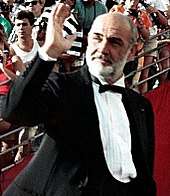
Connery agreed to reprise Bond as an ageing agent 007 in Never Say Never Again, released in October 1983. The title, contributed by his wife, refers to his earlier statement that he would "never again" return to the role. Although the film performed well at the box office, it was plagued with production problems: strife between the director and producer, financial problems, the Fleming estate trustees' attempts to halt the film, and Connery's wrist being broken by fight choreographer, Steven Seagal. As a result of his negative experiences during filming, Connery became unhappy with the major studios and did not make any films for two years. Following the successful European production The Name of the Rose (1986), for which he won a BAFTA award, Connery's interest in more commercial material was revived. That same year, a supporting role in Highlander showcased his ability to play older mentors to younger leads, which became a recurring role in many of his later films. The following year, his acclaimed performance as a hard-nosed Irish-American cop in The Untouchables (1987) earned him his only Academy Award for Best Supporting Actor.[68]
His subsequent box-office hits included Indiana Jones and the Last Crusade (1989), in which he played Henry Jones, Sr., the title character's father, The Hunt for Red October (1990) (where he was reportedly called in at two weeks' notice[69]), The Russia House (1990), The Rock (1996), and Entrapment (1999). In 1996, he voiced the role of Draco the dragon in the film Dragonheart. In 1998, Connery received a BAFTA Academy Fellowship Award.[70]
Connery's later films included several box office and critical disappointments such as First Knight (1995), Just Cause (1995), The Avengers (1998), and The League of Extraordinary Gentlemen (2003); he received positive reviews for his performance in Finding Forrester (2000). He also received a Crystal Globe for outstanding artistic contribution to world cinema. In a 2003 poll conducted by Channel 4 Connery was ranked eighth on their list of the 100 Greatest Movie Stars.[71] The failure of The League of Extraordinary Gentlemen was especially frustrating for Connery, who sensed during shooting that the production was "going off the rails" announced that the director, Stephen Norrington should be "locked up for insanity", and spent considerable effort in trying to salvage the film through the editing process, ultimately deciding to retire from acting rather than go through such stress ever again.[72]
Connery was offered the role of Gandalf in The Lord of the Rings series but declined it, claiming he didn't understand the script.[73] Connery was reportedly offered $30 million along with 15 percent of the worldwide box office receipts for the role, which—had he accepted—would have earned him $450 million.[74][75] Connery also turned down the opportunity to appear as the Architect in The Matrix trilogy for similar reasons.[76] Connery's disillusionment with the "idiots now making films in Hollywood" was cited as a reason for his eventual decision to retire from film-making.[77] In 2005 he recorded voiceovers for a new video game version of his Bond film From Russia with Love.[78] In an interview on the game disc, Connery stated that he was very happy that the producers of the game (EA Games) had approached him to voice Bond.
Retirement
When Connery received the American Film Institute's Lifetime Achievement Award on 8 June 2006, he confirmed his retirement from acting. On 7 June 2007, he denied rumours that he would appear in the fourth Indiana Jones film, stating that "retirement is just too much damned fun".[79] In 2010, a bronze bust sculpture of Connery was placed in Tallinn, the capital of Estonia.[80] The work is located outside Tallinn's Scottish Club, whose membership includes Estonian Scotophiles and a handful of expatriate Scots.[80] Connery briefly came out of retirement in 2012 by voice acting the title character in the animated movie Sir Billi the Vet. Connery served as executive producer for an expanded 80-minute version.[81]
Personal life
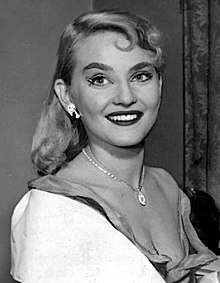
During the production of South Pacific in the mid-1950s, Connery dated a "dark-haired beauty with a ballerina's figure", Carol Sopel, but was warned off by her Jewish family.[82] He then dated Julie Hamilton, daughter of documentary filmmaker and feminist Jill Craigie. Given Connery's rugged appearance and rough charm, Hamilton initially thought he was an appalling person and was not attracted to him until she saw him in a kilt, declaring him to be the most beautiful thing she'd ever seen in her life.[83] He also shared a mutual attraction with jazz singer Maxine Daniels, whom he met at the Empire Theatre. He made a pass at her, but she informed him that she was already happily married with a baby daughter.[84] Connery was married to actress Diane Cilento from 1962 to 1973, though they separated in 1971. They had a son, actor Jason Connery. In her autobiography in 2006 she alleged that he had abused her mentally and physically during their relationship; Connery had been quoted as saying that occasionally hitting a woman was "no big deal".[85][86] Connery cancelled an appearance at the Scottish Parliament because of the controversy, and said he had been misquoted and that any abuse of women was unacceptable.[87] Connery was separated in the early 1970s when he dated Jill St. John,[88] Lana Wood,[89] Carole Mallory[90] and Magda Konopka.[91]
Connery has been married to Moroccan-French painter Micheline Roquebrune (born 1929) since 1975.[92] The marriage has survived a well-documented affair Connery had in the late 1980s with Lynsey de Paul.[93] A keen golfer, Connery owned the Domaine de Terre Blanche[94] in the South of France for twenty years (from 1979) where he planned to build his dream golf course on the 266 acres (108 ha) of land; the dream was realised when he sold it to German billionaire Dietmar Hopp in 1999.[95] He has been awarded an honorary rank of Shodan (1st dan) in Kyokushin karate.[96]
Connery was knighted by Elizabeth II at an investiture ceremony at Holyrood Palace in Edinburgh on 5 July 2000.[97] He had been nominated for a knighthood in 1997 and 1998, but these nominations were reported to have been vetoed by Donald Dewar due to Connery's political views.[58][98] Sean Connery has a villa in Kranidi, Greece. His neighbour is King Willem-Alexander of the Netherlands, with whom he shares a helicopter platform.[99] Michael Caine (who co-starred with Connery in The Man Who Would Be King in 1975) is among Connery's closest friends.[100] Connery is a keen supporter of Scottish Premiership football club Rangers F.C., having changed his allegiance from Celtic.[101]
Political opinions
Connery is a member of the Scottish National Party,[102][103] a centre-left political party campaigning for Scottish independence from the United Kingdom, and has supported the party financially[104] and through personal appearances. His funding of the SNP ceased in 2001, when the UK Parliament passed legislation that prohibited overseas funding of political activities in the UK.[104]
Tax status
In response to accusations that he was a tax exile, Connery released documents in 2003 showing that he had paid £3.7 million in UK taxes between 1997/98 and 2002/03; critics pointed out that had he been continuously resident in the UK for tax purposes, his tax rate would have been far higher.[105][106] In the run-up to the 2014 Scottish independence referendum, Connery's brother Neil said that Connery would not come to Scotland to rally independence supporters, since his tax exile status greatly limited the number of days he could spend in the country.[107]
After Connery sold his Marbella villa in 1999, Spanish authorities launched an investigation into alleged tax evasion by him and his wife, alleging that the Spanish treasury had been defrauded of £5.5 million. Connery was subsequently cleared by the Spanish officials but his wife and 16 others were charged with attempting to defraud the Spanish treasury.[108][109]
See also
References
- "Profile: Sean Connery". BBC News. 12 March 2006. Retrieved 19 March 2007.
- Flockhart, Susan (25 January 2004). "Would The Greatest Living Scot Please Stand Up?; Here they are". Sunday Herald. Archived from the original on 11 September 2016. Retrieved 16 June 2016 – via HighBeam Research.
- "Sir Sean Connery named Scotland's greatest living treasure". STV News. 25 November 2011. Archived from the original on 2 April 2015. Retrieved 6 August 2012.
- "Sexy Celebrity Pictures". CBS News. Retrieved 10 October 2018.
- "Sir Sean's pride at knighthood". BBC. Retrieved 15 March 2019.
- "CONNERY, Sir Sean". Who's Who. ukwhoswho.com. 2015 (online Oxford University Press ed.). A & C Black, an imprint of Bloomsbury Publishing plc. (subscription or UK public library membership required) (subscription required)
- 'Scottish Roots' Biography of Sean Connery
- Family Tree posted on Geneanet
- Familyrelatives.com Case Study 1 - Sean Connery - James Bond
- "Sean Connery Biography". Film Reference. Advameg, Inc. Retrieved 29 September 2007.
- "Case Study 1-Sean Connery-James Bond". Familyrelatives.com. Treequest Limited. Retrieved 6 August 2012.
- Yule 1992, p. 1.
- Connery, Sean; Grigor, Murray (2009). Being a Scot. Phoenix Illustrated.
- "Scottish Genealogy Scottish Ancestry Family Tree Scottish Genealogists". Archived from the original on 12 July 2012. Retrieved 5 March 2013.
- Yule 1992, p. 8.
- Yule 1992, p. 18.
- Yule 1992, p. 21.
- "From the Co-op with love.. the days Sir Sean earned £1 a week". The Scotsman. 21 November 2005. Archived from the original on 13 October 2007. Retrieved 29 September 2007.
- "The Official Website of Sir Sean Connery – Biography". Seanconnery.com. Retrieved 10 March 2010.
- "Catch up on all the Belly Buzz... - Celebrity Veterans - Sean Connery, British Royal Navy 1946-1949". bellybuzz.squarespace.com. Archived from the original on 28 June 2020. Retrieved 26 June 2020.
- Yule 1992, p. 4.
- Davidson, Lynn (22 August 2003). "Even as an unknown, Sean was still a draw". The Scotsman. Retrieved 29 September 2007.
- Yule 1992, p. 28.
- Yule 1992, p. 29.
- Yule 1992, p. 31.
- Wills, Dominic. "Sean Connery – Biography". Tiscali. Archived from the original on 7 July 2013. Retrieved 20 September 2009.
- "1953 Mr. Universe – NABBA". Retrieved 20 September 2009.
- Yule 1992, p. 35.
- Crawford, Kenny (7 December 2016). "Bonnyrigg Rose: Four things you might not know about the Rosey Posey". BBC Scotland. Retrieved 7 December 2016.
- Christopher Bray (2010). "Sean Connery: The measure of a man". p. 27. Faber & Faber,
- "Scottish Junior Football Association > Mud & Glory > Sean Connery". Mud & Glory. April 2005. Archived from the original on 2 June 2015. Retrieved 21 October 2012.
- Yule 1992, p. 36.
- Sellers 1999, p. 21.
- Yule 1992, p. 32-3.
- Yule 1992, p. 38-9.
- Yule 1992, p. 43.
- Yule 1992, p. 45.
- Yule 1992, p. 291.
- Sellers, Robert (December 1999). Sean Connery: a celebration. Robert Hale. p. 42. ISBN 978-0-7090-6125-0. Retrieved 14 July 2011.
- Baldwin, Louis (September 1999). Turning Points: Pivotal Moments in the Careers of 83 Famous Figures. McFarland. p. 53. ISBN 978-0-7864-0626-5. Retrieved 14 July 2011.
- Callan, Michael Feeney (1 November 2002). Sean Connery. Virgin. p. 75. ISBN 978-1-85227-992-9. Retrieved 14 July 2011.
- Pfeiffer, Lee; Lisa, Philip (February 1997). The films of Sean Connery. Carol Pub. Group. ISBN 978-0-8065-1837-4. Retrieved 14 July 2011.
- Morella, Joe; Epstein, Edward Z. (1971). Lana: The Public and Private Lives of Miss Turner. pp. 177–182. New York: Citadel Press.
- "Sean Connery: How he seduced a movie legend and faced the wrath of the Mafia". London Evening Standard. Retrieved 30 May 2019.
- Kohn, George C. (2001). The New Encyclopedia of American Scandal. Facts on File: Library of American History (Revised ed.). p. 388. New York: Infobase Publishing.
- Turner, Lana (1982). Lana: The Lady, the Legend, the Truth (1st ed.). p. 170. New York: Dutton
- Weiler, A. H. (1 July 1959). "Darby O'Gill and the Little People". The New York Times. Retrieved 14 July 2011.
- Wake, Oliver. "Cartier, Rudolph (1904–1994)". Screenonline. Retrieved 25 February 2007.
- Duthel, C (2012). Angelina Jolie - The Lightning Star. London: Lulu. p. 288. ISBN 9781471089350.
- "AFI's 100 Years... 100 Heroes and Villains". AFI. Retrieved 20 December 2013
- Bray, Christopher (3 March 2004). "Sean Connery: The Measure Of A Man". The Daily Telegraph. London.
- "8 Things You Didn't Know About James Bond". Huffington Post. Retrieved 15 March 2019.
- Macintyre, Ben (2009). For Your Eyes Only : Ian Fleming and James Bond. London: Bloomsbury. p. 187. ISBN 9780747598664.
- "Playboy Interview: Sean Connery 1965". Archived from the original on 11 October 2018. Retrieved 10 October 2018.
- Buckland, Damien (2016). Collection Editions James Bond. CreateSpace Independent. ISBN 9781530573257.
- "IGN: Sean Connery Back as Bond". Archived from the original on 29 June 2011. Retrieved 15 March 2019.
- Berman, Eliza (25 August 2015). "Happy Birthday, Sean Connery: See Him as James Bond on the Cover of LIFE". Time.
- Ferguson, Euan (2 October 2004). "Scotch myth". The Observer. Retrieved 18 September 2013.
- Yule 1992, p. 34.
- McGlone, Neil. "Seventy Years of Cannes: Blow-Up in 1967". Criterion Collection. Retrieved 12 January 2020.
- "Winners & Nominees Henrietta Award (World Film Favorites)". Golden Globe Awards. Retrieved 29 September 2017.
- “Sean Connery still has special Bond with movie fans”. Sunday Post. Retrieved 19 March 2019
- “Michael Caine: “People forget I know a few gangsters” Archived 13 June 2018 at the Wayback Machine. Sabotage Times. Retrieved 19 March 2019
- “Robin and Marian” review by Roger Ebert , Chicago Sun-Times. 21 April 1976, Retrieved 19 March 2019
- "A Bridge Too Far, for allied forces and for viewers". The Guardian. Retrieved 22 March 2020.
- "Time Bandits Extras". Channel 4. Archived from the original on 9 April 2009. Retrieved 7 March 2013.
- "FIFA World Cup and Official FIFA Events: Programming" Archived 17 April 2016 at the Wayback Machine. FIFA Films. Retrieved 28 January 2013
- "The 60th Academy Awards (1988) Nominees and Winners". Academy of Motion Picture Arts and Sciences (AMPAS). Archived from the original on 2 April 2015. Retrieved 15 March 2019.
- Harlow, Cas (10 November 2011). "The Hunt for Red October Review". The A.V. Club. Archived from the original on 7 April 2014. Retrieved 11 August 2013.
- Robson, Ben (21 August 2008). "The name's Connery, Sean Connery: the life of Scotland's James Bond". The Times. London. Retrieved 16 March 2019.
- "100 Greatest ... (100 Greatest Movie Stars (Part 1))". ITN Source. Archived from the original on 21 February 2015. Retrieved 31 May 2019.
- "An ignominious exit". Looper.com. Retrieved 28 December 2019.
- "Connery 'turning back on movies'". BBC News. 1 August 2005. Retrieved 6 August 2012.
- "Sean Connery lost $450m refusing Gandalf role". NZ Herald. 21 November 2012. ISSN 1170-0777. Retrieved 22 January 2020.
- Ransom Riggs (20 October 2008). "5 million-dollar mistakes by movie stars". CNN. Retrieved 10 March 2010.
- Norrington, Stephen (Director) (16 December 2003). The League of Extraordinary Gentlemen (DVD). United States: 20th Century Fox.
- Mcdonald, Toby; Watson, Jeremy (31 July 2005). "Never say never, but Connery ends career". The Scotsman. Retrieved 9 April 2011.
- Lipsey, Sid (10 November 2005). "Review: Connery brings Bond back to the U.S.S.R." CNN. Archived from the original on 23 February 2013. Retrieved 6 August 2012.
- "Connery bows out of Indiana film". BBC News. 8 June 2007. Retrieved 29 September 2007.
- "Sean Connery immortalised with Estonian bust". Apnews.myway.com. Archived from the original on 1 January 2016. Retrieved 24 July 2013.
- Carson, Alan (12 April 2010). "Sir Sean makes film comeback as a retired vet". The Scotsman. Edinburgh. Archived from the original on 12 October 2010. Retrieved 7 March 2013.
- Yule 1992, p. 40.
- Yule 1992, p. 41.
- Yule 1992, p. 37.
- "Jealous Connery beat me, says ex-wife". www.scotsman.com.
- "No more free passes to famous men who abuse women". Washington Post.
- "'I don't believe that any level of abuse of women is ever justified under any circumstances' Connery speaks for the first time after cancelling his high-profile appearance at Holyrood's Festival of Politics By Paul Hutcheon". HeraldScotland.
- "Friends Say It's Love". PEOPLE.com. Retrieved 3 June 2020.
- "Bond girl Lana Wood talks about Sean Connery affair". MI6-HQ.COM. Retrieved 3 June 2020.
- "Norman Mailer's Norristown mistress: I've been defamed". Philadelphia Inquirer. Retrieved 3 June 2020.
- "Magda Konopka - The Art and Popular Culture Encyclopedia". www.artandpopularculture.com. Retrieved 3 June 2020.
- "Connery: Bond and beyond". BBC News. 21 December 1999. Retrieved 23 September 2010.
- "Pop star Lynsey de Paul reveals the truth about her love-life". Evening Standard. 10 April 2007. Retrieved 3 June 2020.
- Fearis, Beverley. "'We half expected someone to tuck us in with a goodnight kiss'". The Observer, 1 August 2004. Retrieved 3 September 2009.
- "No doubting Thomas". Executive Golf Magazine. Archived from the original on 5 January 2011. Retrieved 7 March 2013.
- Rogers, Ron. "Hanshi's Corner 1106" (PDF). Midori Yama Budokai. Archived from the original (PDF) on 18 January 2012. Retrieved 20 August 2011.
- "No. 55950". The London Gazette. 22 August 2000. p. 9336.
- "Sir Sean's pride at knighthood". BBC News. 5 July 2000.
- "Dutch prince buys villa next to James Bond actor". BBC News. 16 April 2012. Retrieved 24 July 2013.
- "Michael Caine interview - for his autobiography The Elephant to Hollywood". The Daily Telegraph. 7 May 2016.
- "11 celebrity Scottish football supporters". www.scotsman.com.
- Seenan, Gerard (27 April 1999). "Connery goes on the SNP offensive". The Guardian. Retrieved 22 May 2009.
- Pender, Paul (2 May 1999). "patriotgames". Sunday Herald. Retrieved 22 May 2009.
- "Connery funds SNP through Jersey account". BBC News. 7 March 2003. Retrieved 22 January 2012.
- "Sir Sean lays bare his tax details". BBC News. 6 March 2003. Retrieved 22 January 2012.
- Collinson, Patrick (21 February 2004). "Join the club and become a tax exile". the Guardian.
- Cramb, Auslan (16 September 2014). "Sir Sean Connery's tax exile status keeps him away from independence debate, says brother" – via www.telegraph.co.uk.
- "Sean Connery's wife faces €22m fine over Marbella villa sale".
- Gayle, Damien (27 November 2015). "Sean Connery's wife charged with Spanish property tax fraud". the Guardian.
Bibliography
- Cohen, Susan; Cohen, Daniel (1985). Hollywood Hunks and Heroes. New York City: Exeter Books. p. 33. ISBN 978-0-671-07528-6. OCLC 12644589.CS1 maint: ref=harv (link)
- Sellers, Robert (December 1999). Sean Connery: A Celebration. Robert Hale. ISBN 978-0-7090-6125-0. Retrieved 14 July 2011.CS1 maint: ref=harv (link)
- Yule, Andrew (1992). Sean Connery: Neither Shaken Nor Stirred. Little, Brown Book Group. ISBN 978-0-7515-4097-0.CS1 maint: ref=harv (link)
External links
| Wikimedia Commons has media related to Sean Connery. |
| Wikiquote has quotations related to: Sean Connery |
- Official website
- Sean Connery at the British Film Institute
- Sean Connery on IMDb
- Sean Connery at the Internet Broadway Database

- Sean Connery at the TCM Movie Database

- Sean Connery at Rotten Tomatoes
- BBC: Sean Connery Biography (1999)
- Photographs and literature
- Sean Connery (Aveleyman)
- young Sean body building pose, 1950s